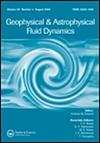平流层旋转流幅值调制的实验与长期高性能计算
IF 1.1
4区 地球科学
Q3 ASTRONOMY & ASTROPHYSICS
Geophysical and Astrophysical Fluid Dynamics
Pub Date : 2020-04-15
DOI:10.1080/03091929.2020.1795647
引用次数: 6
摘要
本文描述了一种结合实验和高性能计算的平流层旋转不稳定性(SRI)新特性的研究。在稳定的轴向密度分层下,SRI是一个由经典Taylor-Couette (TC)系统组成的纯水动力不稳定性。与经典的非分层TC系统相比,密度分层导致了边缘不稳定过渡的变化,使得在没有分层的情况下流动稳定的区域变得不稳定。这一特点使SRI成为行星和天体物理学应用中的一个相关现象,特别是在吸积盘理论中。尽管在理解平流层旋转流方面取得了许多进展,但实验数据与非线性数值模拟的对抗仍然相关,因为涉及到SRI模式的线性方面和非线性相互作用仍然需要更好地理解。这些比较还揭示了在SRI中尚未观察到的新的非线性现象和模式,这些现象和模式有助于我们理解地球物理流动。研究这些sri相关现象的实验由两个可以独立旋转的圆柱体组成,两个垂直圆柱体之间的空间充满硅油。为了获得沿筒轴方向稳定的密度分层,对装置的底盖进行冷却,对其顶部进行加热,使温度差变化,形成轴向线性梯度,使弗劳德数在1.5Experiments and long-term high-performance computations on amplitude modulations of strato-rotational flows
The present paper describes a combined experimental and high-performance computing study of new specific behaviours of the Strato-Rotational Instability (SRI). The SRI is a purely hydrodynamical instability that consists of a classical Taylor–Couette (TC) system under stable axial density stratification. The density stratification causes a change on the marginal instability transition when compared to classical non-stratified TC systems, making the flow unstable in regions where – without stratification – it would be stable. This characteristic makes the SRI a relevant phenomenon in planetary and astrophysical applications, particularly in accretion disk theory. In spite of many advances in the understanding of strato-rotational flows, the confrontation of experimental data with non-linear numerical simulations remains relevant, since involved linear aspects and non-linear interactions of SRI modes still need to be better understood. These comparisons also reveal new non-linear phenomena and patterns not yet observed in the SRI that can contribute for our understanding of geophysical flows. The experiment designed to investigate these SRI-related phenomena consists of two cylinders that can rotate independently, with the space between these two vertical cylinders filled with a silicon oil. For obtaining a stable density stratification along the cylinder axis, the bottom lid of the setup is cooled, and its top part is heated, with temperature differences varying between , establishing an axial linear gradient, leading to Froude numbers between 1.5
求助全文
通过发布文献求助,成功后即可免费获取论文全文。
去求助
来源期刊

Geophysical and Astrophysical Fluid Dynamics
地学天文-地球化学与地球物理
CiteScore
3.10
自引率
0.00%
发文量
14
审稿时长
>12 weeks
期刊介绍:
Geophysical and Astrophysical Fluid Dynamics exists for the publication of original research papers and short communications, occasional survey articles and conference reports on the fluid mechanics of the earth and planets, including oceans, atmospheres and interiors, and the fluid mechanics of the sun, stars and other astrophysical objects.
In addition, their magnetohydrodynamic behaviours are investigated. Experimental, theoretical and numerical studies of rotating, stratified and convecting fluids of general interest to geophysicists and astrophysicists appear. Properly interpreted observational results are also published.
 求助内容:
求助内容: 应助结果提醒方式:
应助结果提醒方式:


